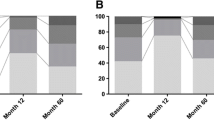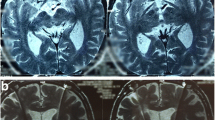Abstract
The aim of this study was to evaluate the clinical efficacy of deep brain stimulation (DBS) and subthalamic nuclei stimulation (STN) in the treatment of Parkinson’s disease. A total of 32 patients with Parkinson’s disease who continuously treated in our hospital with STN–DBS from November 2011 to November 2013 were selected. All the patients received follow-up evaluation, psychological status questionnaire survey and analysis before surgery and 3 months after surgery using unified Parkinson’s disease rating scale (UPDRS), Self-rating depression scale (SDS), and symptom checklist (SCL-90). After turned on the impulse generator (IPG), the daily activities and motor function of UPDRS in all the 32 cases of Parkinson’s disease patients were in “turn off” state; the mean improvement rates were 51.7 and 60.9 %; when the daily activities and motor function in the state of “turn on”, the mean improvement rates were 21.4 and 22.3 %. In 20 cases, the preoperative SDS > 50, the levels of depression, anxiety, somatization, interpersonal sensitivity, hostility, fear, and paranoia of SCL-90 were significant higher than the Chinese traditional levels (P < 0.05). Comparison of the preoperative and postoperative depression, somatization, fear, anxiety, and psychotic factor of SCL-90 found that there was negative correlation between preoperation and postoperation, and the differences were significant (P < 0.05), while there were no significant differences in interpersonal sensitivity and paranoia (P > 0.05). STN–DBS can improve the motor function and ability of daily life of Parkinson’s disease patients and can significantly improve the psychological condition of the patients with Parkinson’s disease and depression; it is a safe and effective method to the treatment of Parkinson’s disease.


Similar content being viewed by others
References
Witt, K., Daniels, C., Reiff, J., et al. (2008). Neuropsychological and psychiatric changes after deep brain stimulation for Parkinson’s disease: A randomised, multicentre study. Lancet Neurology, 7(7), 605–614.
Obeso, I., Wilkinson, L., Rodríguez-Oroz, M. C., et al. (2013). Bilateral stimulation of the subthalamic nucleus has differential effects on reactive and proactive inhibition and conflict-induced slowing in Parkinson’s disease. Experimental Brain Research, 226(3), 451–462.
Mehanna, R., & Lai, E. C. (2013). Deep brain stimulation in Parkinson’s disease. Translational Neurodegeneration, 2(1), 22.
Li, D., Cao, C., Zhang, J., et al. (2013). Subthalamic nucleus deep brain stimulation for Parkinson’s disease: 8 years of follow-up. Translational Neurodegenecr, 2(1), 11.
Liang, J. C., Hu, X. W., Zhou, X. P., et al. (2013). Accesement of nonmotor symptorms for subthalamic nucleus deep brain stimulation of Parkinson’s disease: A corhort study. Chinese Journal of Stereotactic Neurosurgery, 26, 193–196.
Li, J. Y., Zhang, Y. Q., & Li, Y. J. (2013). Long-term follow up of bilateral subthalamic nucleus stimulation for Parkinson’ s disease cases. Journal of Clinical Neurosurgery, 10, 139–141.
Wagle Shukla, A., & Okun, M. S. (2014). Surgical treatment of Parkinson’s disease: Patients, targets, devices, and approaches. Neurotherapeutics, 11(1), 47–59.
Buhmann, C., Maintz, L., Hierling, J., et al. (2014). Effect of subthalamic nucleus deep brain stimulation on driving in Parkinson disease. Neurology, 82(1), 32–40.
Xiao, W. M., Xu, L., & Chen, Y. K. (2011). The mechanism of Parkinson’s disease combined with depression. Chinese Journal of Nervous and Mental Diseases, 37, 189–191.
Volkmann, J., Daniels, C., & Witt, K. (2010). Neuropsychiatric effects of subthalamic neurostimulation in Parkinson disease. Nature Reviews Neurology, 6(9), 487–498.
Liang, Q., Gao, G., Wang, X., et al. (2006). Long-term clinical benefit of Subthalamic nucleus deep brain stimulation (STN-DBS) in Parkinson’s disease complicated depression. Chinese Journal of Neuromedicine, 5, 1129–1131.
Volkmann, J., Albanese, A., Kulisevsky, J., et al. (2009). Long-term effects of pallidal or subthalamic deep brain stimulation on quality of life in Parkinson’s disease. Movement Disorders, 24(8), 1154–1161.
Amara, A. W., Watts, R. L., & Walker, H. C. (2011). The effects of deep brain stimulation on sleep in Parkinson’s disease. Therapeutic Advances in Neurological Disorders, 4(1), 15–24.
Wang, X., Chang, C., Geng, N., et al. (2009). Effect of bilateral Deep Brain Stimulation of the subthalamic nucleus on depression in patients with Parkinson’s disease. Chinese Journal of Nervous and Mental Diseases, 35(2), 88–92.
Lee, M. A., Walker, R. W., Hildreth, A. J., et al. (2006). Individualized assessment of quality of life in idiopathic Parkinson’s disease. Movement Disorders, 21(11), 1929–1934.
Author information
Authors and Affiliations
Corresponding author
Rights and permissions
About this article
Cite this article
Tao, Y., Liang, G. Effect of Subthalamic Nuclei Electrical Stimulation in the Treatment of Parkinson’s Disease. Cell Biochem Biophys 71, 113–117 (2015). https://doi.org/10.1007/s12013-014-0169-0
Published:
Issue Date:
DOI: https://doi.org/10.1007/s12013-014-0169-0




